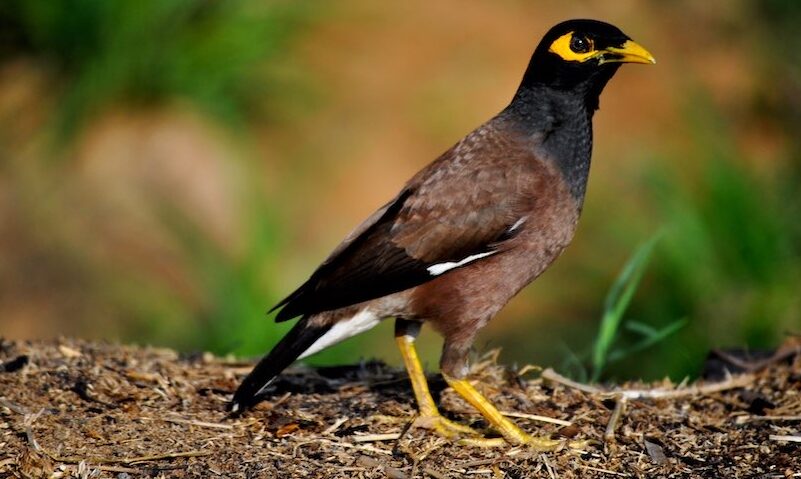
COMMONLY known as “cane toads of the sky”, Indian myna birds have been deemed one of the 100 most invasive species in the world and Canberra man Bill Handke is calling on the community to help reduce the estimated 150,000 of them in the ACT.
A keen birdwatcher and president of the Canberra Indian Myna Action Group (CIMAG), Bill described the ACT government’s recent declaration of the bird as a pest species as a “profound decision”.
But he also says it’s only the first step in tackling the issue.
“Our worry is that the government might see the declaration as an end in itself,” he says.
“Mynas are very intelligent and very adaptable animals. Unless there’s on-the-ground, practical activity to actually control the birds then we’ll just see this problem continue.”
Bill says he started the Action Group in 2006 after seeing first hand how destructive the species can be.
“Research has shown that as Indian myna numbers go up, native bird numbers go down,” he says.
“Indian mynas aggressively evict native birds such as kookaburras and parrots from their nests, dumping out their eggs and even killing their chicks.
“Because they can be heavily infested with bird mites, their droppings can contain viruses and pathogens so they also represent a human health risk.”
Native to the Indian subcontinent, the species was introduced to Australia in the late 1800s to reduce the numbers of insects feeding on gardens and vineyards around Melbourne.
Before this children were engaged to pick insects off the plants, but when Victoria established mandatory schooling in 1872 a new system was required, a system that would explode in numbers.
“The mynas didn’t eat the insects, they preferred the grapes,” says Bill.
“Their numbers skyrocketed throughout Australia and around 100 years later they arrived in Canberra.
“That was due to a misguided newcomer from Sydney who released a dozen birds because he missed hearing their call.”
 Since CIMAG’s founding 15 years ago, Bill says they’ve removed a minimum of 74,900 mynas from Canberra through 2660 members setting traps in their backyards.
Since CIMAG’s founding 15 years ago, Bill says they’ve removed a minimum of 74,900 mynas from Canberra through 2660 members setting traps in their backyards.
“The trap has an entrance tunnel and it’s shaped so that it narrows and slopes down meaning birds like magpies, currawongs and crows don’t get caught,” he says.
“We also use cat food as bait so we don’t get seed eaters like rosellas, so it discriminates for mynas very well.”
After the mynas are trapped, Bill says they are killed using carbon monoxide, a method he describes as the most humane, painless and stress-free means of doing so.
Despite the species going from the third most common bird in Canberra to the 24th through the work of the group, he says the region has started to see a resurgence in numbers.
“It comes down to a good breeding season and, as we haven’t been able to provide traps to people who want them, we’ve missed an opportunity to get on top of them,” he says.
In previous years, the traps were made by inmates of the Alexander Maconochie Centre with materials provided by the action group, but production stopped after the prison’s expansion in 2017.
“What we’d really like is for [Corrections Minister] Mick Gentleman to ask the jail to resume trap making,” says Bill.
With more traps set in myna hotspots, Bill says there’s still a chance to reduce the impact the species has on the environment.
“Schools, shopping centres, horse stables, the airport, the zoo, there are key areas where we see mynas, due to scraps and waste laying around,” he says.
“In the occasions where schools let us set traps during holidays it has been very successful. Just four or five days in one school they caught 70 mynas.”
While Bill believes it’s now too late to eradicate the species, he says there is still a chance of keeping its numbers low with the right steps.
“It’s all going to depend on the government’s response from here. We want to work with them on this issue,” he says.
“I dont know of anybody who likes to kill animals, but if the only way to protect our wildlife is by active culling then that’s what you have to do.”
More at indianmynaaction.org.au
Who can be trusted?
In a world of spin and confusion, there’s never been a more important time to support independent journalism in Canberra.
If you trust our work online and want to enforce the power of independent voices, I invite you to make a small contribution.
Every dollar of support is invested back into our journalism to help keep citynews.com.au strong and free.
Thank you,
Ian Meikle, editor




Leave a Reply